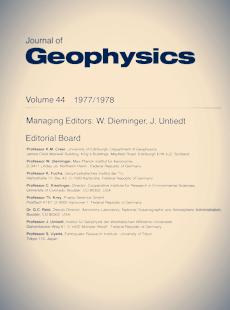The reflectivity method for a buried source
Article Sidebar
Published:
Dec 12, 1977
Keywords:
Theoretical seismograms,
Buried source,
Thomson-Haskell matrix formalism
Volumes

Vols. 1-18 (1924-1944), ISSN 0044-2801
Main Article Content
R. Kind
Seismological Central Observatory, Erlangen, Germany
Abstract
The reflectivity method for the computation of theoretical seismograms is extended for the case of a point source buried in a layered medium. Two sources are considered, an explosive source and a vertical single force. Appearing accuracy problems are solved. Poles of Rayleigh waves are shifted away from the real axis of the wavenumber plane by introducing attenuation, in order to allow numerical integration along the real axis. The results of several computations are discussed. This method allows the computation of complete seismograms including surface waves, leaking modes and all body wave phases, including depth phases like pP.
 ARK: https://n2t.net/ark:/88439/y005596
ARK: https://n2t.net/ark:/88439/y005596
Permalink: https://geophysicsjournal.com/article/75
Article Details
How to Cite
Section
References
Červeny, V. (1974) Reflection and transmission coefficients for transition layers. Studia geophys. geodaet. 18:59-68,
Dunkin, J.W. (1965) Computation of modal solutions in layered media at high frequencies. Bull. Seism. Soc. Am. 55(2):335-358
Ewing, W.M., Jadetzky, W.S. and Press, F. (1957) Elastic waves in layered media, New York, McGrawHill
Fuchs, K. (1968) The reflection of spherical waves from transition zones with arbitrary depth-dependent elastic moduli and density. Special issue. J. Phys. Earth 16:27-41
Harkrider, D.G. (1964) Surface waves in multilayered elastic media, 1. Rayleigh and Love waves from buried sources in a multilayered elastic halfspace. Bull. Seism. Soc. Am. 54:627-679
Harkrider, D.G. (1970) Surface waves in multilayered elastic media. Part II. Higher modes spectra and spectral ratios from point sources in plane layered earth models. Bull. Seism. Soc. Am. 60:1937-1987
Haskell, N.A. (1953) Dispersion of surface waves on multilayered media. Bull. Seism. Soc. Am. 43:17-34
Haskell, N.A. (1962) Crustal reflection of plane P ans SV waves, J. Geophys. Res. 67:4751-4767
Lamb, H. (1904) On the propagation of tremors over the surface of an elastic solid. Phil. Trans. R. Soc. (London) A, 203:1-42
Muller, G. (1977) Earth-flattening approximation for body waves derived from geometric ray theoryimprovements, corrections and range of applicability. J. Geophys. 42:429-436
Muller, G., Kind, R. (1976) Observed and computed seismogram sections for the whole earth, Geophys. J.R. astr. Soc., 44:699-716
Schwab, F.A., Knopoff, L. (1972) Fast surface wave and free mode computations. Methods in computational physics, Vol. II, B.A. Bolt, Ed. New York: Academic Press
Watson, T.H. (1970) Fast computation of Rayleigh wave dispersion in a layered halfspace. Bull. Seism. Soc. Am. 60:161-166
Dunkin, J.W. (1965) Computation of modal solutions in layered media at high frequencies. Bull. Seism. Soc. Am. 55(2):335-358
Ewing, W.M., Jadetzky, W.S. and Press, F. (1957) Elastic waves in layered media, New York, McGrawHill
Fuchs, K. (1968) The reflection of spherical waves from transition zones with arbitrary depth-dependent elastic moduli and density. Special issue. J. Phys. Earth 16:27-41
Harkrider, D.G. (1964) Surface waves in multilayered elastic media, 1. Rayleigh and Love waves from buried sources in a multilayered elastic halfspace. Bull. Seism. Soc. Am. 54:627-679
Harkrider, D.G. (1970) Surface waves in multilayered elastic media. Part II. Higher modes spectra and spectral ratios from point sources in plane layered earth models. Bull. Seism. Soc. Am. 60:1937-1987
Haskell, N.A. (1953) Dispersion of surface waves on multilayered media. Bull. Seism. Soc. Am. 43:17-34
Haskell, N.A. (1962) Crustal reflection of plane P ans SV waves, J. Geophys. Res. 67:4751-4767
Lamb, H. (1904) On the propagation of tremors over the surface of an elastic solid. Phil. Trans. R. Soc. (London) A, 203:1-42
Muller, G. (1977) Earth-flattening approximation for body waves derived from geometric ray theoryimprovements, corrections and range of applicability. J. Geophys. 42:429-436
Muller, G., Kind, R. (1976) Observed and computed seismogram sections for the whole earth, Geophys. J.R. astr. Soc., 44:699-716
Schwab, F.A., Knopoff, L. (1972) Fast surface wave and free mode computations. Methods in computational physics, Vol. II, B.A. Bolt, Ed. New York: Academic Press
Watson, T.H. (1970) Fast computation of Rayleigh wave dispersion in a layered halfspace. Bull. Seism. Soc. Am. 60:161-166











